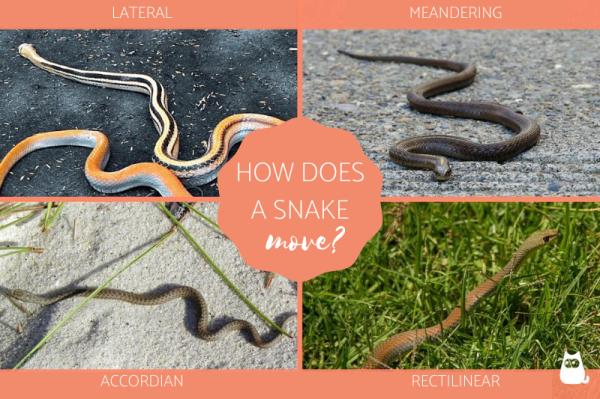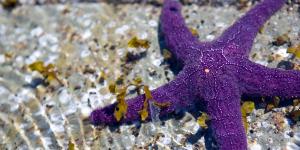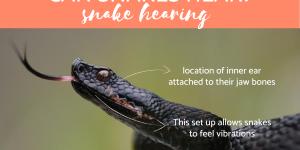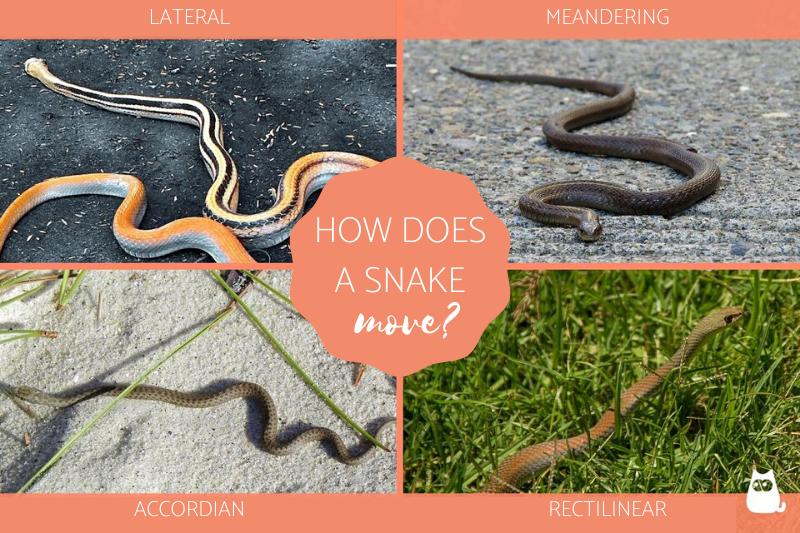How Does a Snake Move?


Snakes are vertebrate and ectothermic animals. They are also one of the few organisms that propel themselves by sliding their bodies on the ground. This movement is called slithering. It's extraordinary how snakes are able to move their limbless bodies through various terrains including rocks, sand, mud, and leaf litter.
In this AnimalWised article we're going to explain how a snake moves. We'll go through the four slithering movements snakes do to move through different types of terrain and to survive in the wild.
How do snakes move if they don't have legs?
Snakes move over a variety of surfaces and are also capable of climbing from tree trunks to brick walls. But how do snakes move if they don't have legs?
Snakes crawl thanks to a series of flexible scales on their bellies and a series of muscles which are activated when the snake begins to move. This gives them friction during movement, allowing them to crawl. When snakes move, the trailing edges of the scales on their drag against the ground. Thanks to this, their muscles can be propelled forward, allowing them to move according to the terrain they are in.
For example, the horned rattlesnake (Bothriechis schlegelii) has its tricks to survive the sandy habitats in which it lives, rocking its head and upper body forward and sideways. The lower part of the body and the tail with the belly raised above the hot sand, leaving a drawing in the sand in the shape of a "J".
Other species can climb trees. To achieve this, they wind up to the trunk and little by little they go up like an accordion thanks to their tail, with which they "grab" the tree. Then they stretch their heads and kick forward to "jump" to another surface.
Learn more about a snake's anatomy by reading our article about if snakes have bones.
How do snakes move? - Types of movements
In general, depending on the species and the environment where it lives, snakes can crawl in four different ways:
- By lateral movement: this method allows snakes to slide on more slippery and not as firm surfaces, such as mud or sand. The animal stretches its head forward while its body continues the movement, then this is repeated as it progresses, first contracting the muscles on one side and then the other.
- By meandering movement: this allows the snake to slide on almost any type of surface, thanks to undulating movements. This movement helps snakes slither through slippery surfaces. This method is present in almost all types of snakes.
- By accordion movement: this is one of the most difficult movements for snakes, but it is very effective for moving around in very small places. The back of the body is the anchor, allowing them to push and extend the front of their body. Then they do the same by exchanging the parts, that is why it is called an "accordion" movement. It is common of vipers and rattlesnakes, between which are the most poisonous snakes.
- By rectilinear movements: in this method the snake makes slower movements in a linear direction while having their body straight up. This method is very different to the rest we have mentioned. This movement is used by larger species, such as boas (family Boidae), where their own weight forces them to move in this way.
In the following Youtube video by Bruce Jayne, he will further explain how a snake moves from an anatomical stand point.

Other snake facts
Snakes have a great variety of adaptations and peculiarities that make them unique animals and that over time have aroused fear and wonder. On the other hand, they have other characteristics that most of us did not know and that we will name below:
- Snake species exist almost everywhere in the world: except in places with very cold climates, such as Antarctica, and we can find them both in terrestrial environments, purely arboreal, and in water.
- They are tetrapods: despite not having limbs, they are tetrapods. Like other animals in this group that do not have legs, their ancestors had four legs. However, some studies indicate that they used their limbs not to walk, but to forage for food and during mating.
- Long seasons without feeding: they can go long periods without feeding, up to about six months, during which time they remain more inactive and their metabolism is reduced more than 70%.
- They take care of their young: some species, such as boideos, have parental care. Meaning that their parents will care for them in some way, such as protecting their young by wrapping them around their bodies or creating a special nest with herbs and twigs that allow their young to drag themselves out using the tail.
- Cannibalism : Certain species of rattlesnakes, for example, cannibalize un hatched eggs or hatchlings that do not survive, which involves recovering some of the energy lost during reproduction.
- They are cannot be hypnotised: Cobra snakes (Ophiophagus hannah), contrary to popular belief, cannot be hypnotised by snake charmers. Animals are simply drawn to the movement of the instrument their keepers use and rise from the ground to closely follow the instrument.
- They are not deaf: these animals are not deaf, they can hear through vibrations of the air and the ground using their body attached to the ground and the bones of the jaw, which transfers the sound to their inner ear. Learn more in our article about snakes hearing system.
- Some can “fly”: there are species that can “fly”. To be specific, they can glide from one tree to another by flattening their bodies and propelling themselves by jumping.
- Various sizes: the smallest snake in the world is about 9 to 10 cm long. It's called Tetracheilostoma carlae and is endemic to forests on the Barbados islands. While the largest and longest snake that exists is more than 10 meters long and is called the anaconda (Eunectes murinus), endemic to South America.
If you want to read similar articles to How Does a Snake Move?, we recommend you visit our Facts about the animal kingdom category.
- Gray, J. (1946). T he mechanism of locomotion in snakes . Journal of experimental biology, 23 (2), 101-120.
- Martill, DM, Tischlinger, H., & Longrich, NR (2015). A four-legged snake from the Early Cretaceous of Gondwana . Science, 349 (6246), 416-419.
- Marvi, H., Cook, JP, Streator, JL, & Hu, DL (2016). Snakes move their scales to increase friction. Biotribology, 5, 52-60.





